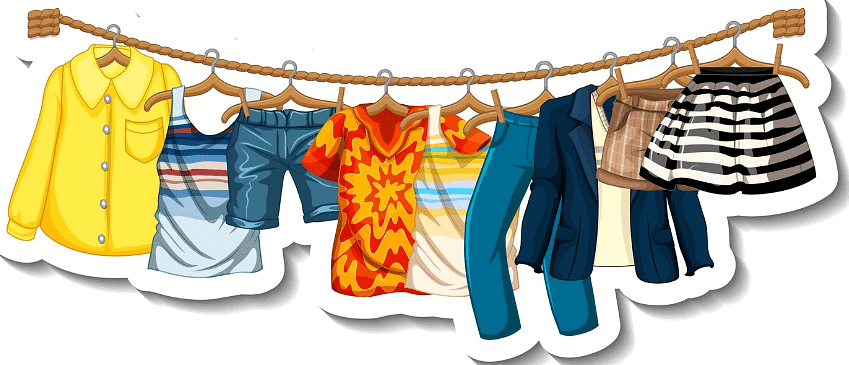Clothes - 2 Class 3 Worksheet SST
 Q1: Multiple Choice Questions (MCQs)
Q1: Multiple Choice Questions (MCQs)
(i) What do our clothes tell about us?
(a) Our favorite colors
(b) Our age and occupation
(c) Our hobbies
Ans: (b)
Our clothes can give information about our age, occupation, and the climate of the place we live in.
(ii) What do some clothes like sari, shawl, and dhoti have in common?
(a) They are stitched clothes.
(b) They are made of animal skins.
(c) They are unstitched clothes.
Ans: (c)
Sari, shawl, and dhoti are examples of unstitched clothes that are draped around the body.
(iii) What was one of the earliest materials used by humans to make clothes?
(a) Animal skins
(b) Cotton fabric
(c) Plastic
Ans: (a)
In the early stages, humans used animal skins to cover themselves as a way to protect from heat or cold.
(iv) When did stitched clothes become popular?
(a) During ancient times
(b) In recent times
(c) Stitched clothes have never become popular.
Ans: (b)
Stitched clothes gained popularity later, while for a long time, people used unstitched clothes like saris, shawls, and dhotis.
(v) What has become a universal aspect of clothing?
(a) Animal skins
(b) Unstitched clothes
(c) Clothes making a statement
Ans: (c)
Clothes making a statement has become a universal aspect, as they reflect various aspects of our identity and culture.
Q2: True/False Statements
(i) Clothes can reveal information about a person's age and occupation.
Ans: True - Clothes can provide insights into a person's age, occupation, and cultural background.
(ii) Stitched clothes like shirts and pants were used by humans from the very beginning.
Ans: False - Stitched clothes like shirts and pants became popular much later in human history. Initially, people used materials like animal skins.
(iii) Sari, shawl, and dhoti are examples of stitched clothes.
Ans: False - This statement is false. Sari, shawl, and dhoti are examples of unstitched clothes that are draped around the body.
(iv) Our clothes don't communicate any information about us to others.
Ans: False - Our clothes communicate information about our age, occupation, climate, and cultural identity to others.
(v) Clothes that are draped around the body are called unstitched clothes.
Ans: True - Clothes like saris, shawls, and dhotis that are not sewn together but rather draped around the body are referred to as unstitched clothes.

Q3: Fill in the Blanks
(i) Clothes can tell us about the _______ in which we live.
Ans: climate
This sentence refers to how clothes provide information about the climate of the place where we reside.
(ii) Unstitched clothes like sari and dhoti are _______ around the body.
Ans: draped
Unstitched clothes like saris and dhotis are draped around the body instead of being stitched.
(iii) The story of clothes is a ______ one.
Ans: long
The sentence indicates that the history of clothes is quite long and has evolved over time.
(iv) In the past, humans used tree leaves, tree bark, and ______ to cover themselves.
Ans: animal skins
This statement mentions some of the early materials that humans used to create clothing, including animal skins.
(v) Stitched clothes became popular much _____ in history.
Ans: later
This sentence indicates that stitched clothes gained popularity relatively later in the history of clothing.
Q4: Answer the following questions
(i) How do clothes make a statement about an individual's background and preferences?
Ans: Clothes can indicate information about an individual's climate, occupation, age, and cultural origin. For example, traditional clothing like a kimono suggests Japanese culture, while a suit and tie may signal a formal occupation.
(ii) What were some of the early materials used by humans for clothing before the invention of woven fabric?
Ans: Early humans used tree leaves, tree bark, and animal skins as materials for clothing before learning to weave fabric.
(iii) Why do unstitched garments like the sari, shawl, and dhoti continue to be popular in some cultures?
Ans: Unstitched garments like the sari, shawl, and dhoti are popular because of their simplicity, comfort, and cultural significance. They are versatile and well-suited to the climate and customs of various regions.
(iv) What is the main message the passage conveys about clothing's historical development and cultural significance?
Ans: The passage highlights that clothing initially served as a means to protect individuals from the elements and has since evolved to convey cultural, climatic, and occupational information. Clothes also make a statement about an individual's background and preferences.
FAQs on Clothes - 2 Class 3 Worksheet SST
| 1. What are the different types of clothes? |  |
| 2. How do I choose the right size of clothes? |  |
| 3. What is the importance of fabric in clothing? |  |
| 4. How should I care for my clothes to make them last longer? |  |
| 5. Where can I donate clothes that I no longer need? |  |





















